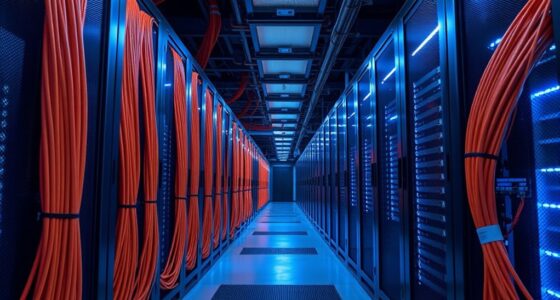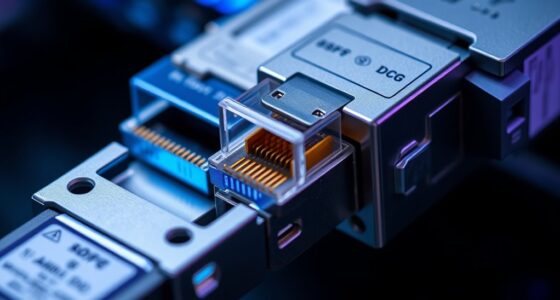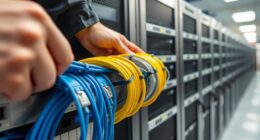Implementing energy-efficient cabling solutions is essential for modern network environments. By choosing wireless technologies, optimizing power management, and using high-quality cables, you can reduce energy consumption and operational costs. But achieving true efficiency requires careful planning and smart choices. If you’re looking to create a sustainable, cost-effective infrastructure, understanding the latest strategies can make all the difference—so, what steps should you take next?
Key Takeaways
- Adopt wireless technologies like Wi-Fi 6 and 5G to eliminate extensive cabling and reduce energy consumption.
- Implement intelligent power management systems that enable network devices and switches to enter low-power states during inactivity.
- Use high-quality, energy-efficient cables with proper insulation and shielding to minimize energy loss and optimize performance.
- Incorporate advanced cable designs that support higher data rates with reduced power requirements, enhancing sustainability.
- Organize cabling with strategic layouts and vertical storage to improve airflow, reduce clutter, and lower overall energy use.

As technology advances, guaranteeing your cabling infrastructure is energy-efficient becomes increasingly important. With the rising demand for sustainable solutions, it’s crucial to explore alternatives that reduce energy consumption without compromising performance. One effective approach is to contemplate wireless alternatives where applicable. Wireless connectivity eliminates the need for extensive physical cabling, which not only cuts down on material usage but also minimizes energy required for installation and maintenance. Devices that communicate wirelessly often consume less power compared to traditional wired setups, especially when optimized with modern standards like Wi-Fi 6 or emerging 5G networks. These technologies are designed to be energy-efficient, allowing your network to operate effectively while using less power overall.
In addition to adopting wireless options, focusing on power management within your cabling infrastructure can markedly boost energy efficiency. Implementing intelligent power management systems enables you to control and reduce energy use during periods of low activity or downtime. For example, network switches and connected devices can be configured to enter low-power states when idle, preventing unnecessary energy drain. Power-over-Ethernet (PoE) technology also offers a streamlined way to deliver power and data through a single cable, which simplifies infrastructure and reduces energy loss. Properly managing power ensures that your cabling system only consumes energy when necessary, leading to lower operational costs and a smaller environmental footprint.
You should also contemplate the quality and specifications of your cabling materials to maximize efficiency. High-performance cables with better insulation and shielding help reduce energy loss over long distances, ensuring that your network remains reliable and energy-efficient. Proper installation techniques, such as avoiding unnecessary cable runs and maintaining appropriate distances, support ideal power flow. Regular maintenance and audits can identify inefficiencies, allowing you to replace outdated or damaged cables that could be wasting energy. Combining these practices with smart power management tools creates a more sustainable infrastructure.
Furthermore, advancements in cable design are continually improving energy efficiency. For instance, newer cable types are engineered to handle higher data rates with less power consumption, making them suitable for demanding applications. Integrating energy-efficient cabling solutions with wireless alternatives and intelligent power management strategies positions your infrastructure for future growth while aligning with sustainability goals. Additionally, utilizing vertical storage solutions can help organize cables neatly, reducing clutter and improving airflow, which indirectly contributes to energy savings. This holistic approach not only reduces your energy costs but also enhances your network’s reliability and scalability. As you implement these strategies, you’ll find that maintaining an energy-efficient cabling system isn’t just good for the environment—it’s a smart business decision that pays off over time.
Frequently Asked Questions
How Do Cable Materials Impact Energy Efficiency?
Cable materials directly impact energy efficiency through cable insulation and conductor resistance. Thinner, high-quality insulation reduces energy loss, while low-resistance conductors, like copper or aluminum, allow electricity to flow more smoothly. When you choose materials with ideal insulation and low resistance, you minimize energy loss, save costs, and improve overall system efficiency. Your selection of suitable cable materials is essential for maximizing energy conservation and reliable performance.
What Are the Latest Innovations in Eco-Friendly Cabling?
You’ll find that the latest innovations in eco-friendly cabling focus on integrating wireless alternatives to reduce material use and simplify installation. Manufacturers now prioritize sustainable manufacturing processes, using biodegradable or recyclable materials to lessen environmental impact. These advancements help you lower energy consumption and promote greener infrastructure. By adopting these cutting-edge solutions, you support sustainability efforts while enjoying reliable, energy-efficient connectivity that aligns with your eco-conscious goals.
How Can Installation Practices Enhance Energy Savings?
You can enhance energy savings by focusing on proper cable management and installation techniques. Keep cables organized to reduce energy loss and prevent overheating. Use efficient routing to minimize cable length and resistance. Guarantee connections are secure, avoiding unnecessary energy consumption. Regularly inspect and maintain cabling systems, and adopt best practices like labeling and planning layouts. These steps optimize performance, reduce waste, and maximize energy efficiency in your installation.
Are There Specific Certifications for Energy-Efficient Cables?
Yes, there are specific certifications for energy-efficient cables. Certification standards like UL and IEC guarantee cables meet safety and efficiency criteria. Eco label programs, such as the EU Ecolabel, verify that cables are environmentally friendly and energy-efficient. When selecting cables, look for these certifications to guarantee you’re choosing products that adhere to recognized energy-saving standards, helping you reduce your overall energy consumption and support sustainability efforts.
What Is the Typical Lifespan of Energy-Efficient Cabling?
Think of energy-efficient cables as reliable friends who stand by you for years. Typically, their lifespan ranges from 10 to 25 years, depending on cable durability and environmental conditions. Proper maintenance requirements, like regular inspections and avoiding physical stress, can prolong this life. Investing in high-quality, certified cables ensures you won’t be left in the dark prematurely, keeping your energy use efficient and your systems running smoothly.
Conclusion
By embracing energy-efficient cabling solutions, you’re planting seeds for a greener future. Think of your network as a delicate garden, where smart choices and careful maintenance let it flourish with minimal energy waste. As you weave these sustainable practices into your infrastructure, you’ll see your efforts blossom into cost savings and environmental harmony. Remember, each mindful cable run is like watering your plants—nurturing a healthier, more vibrant world with every connection you make.









